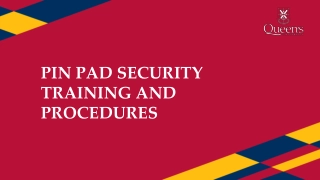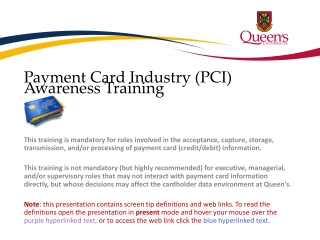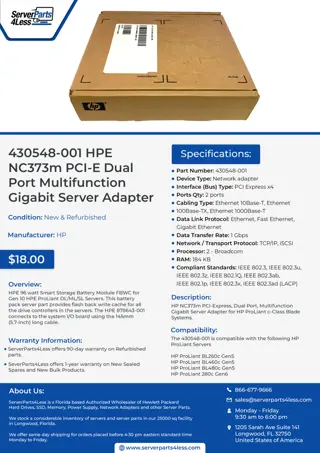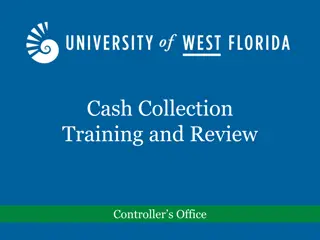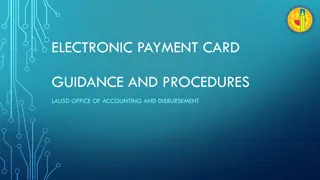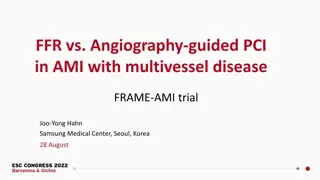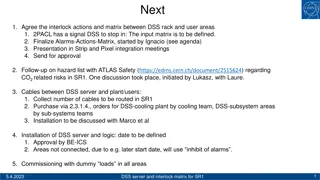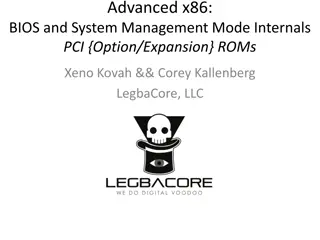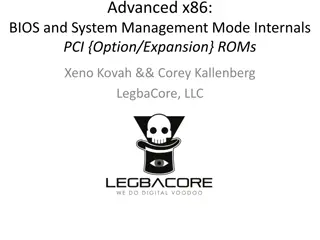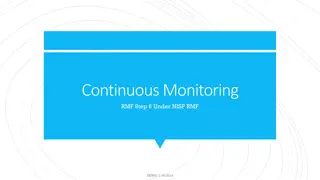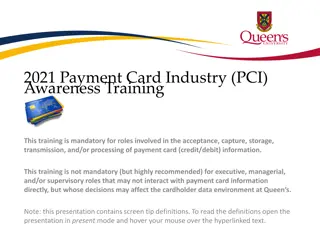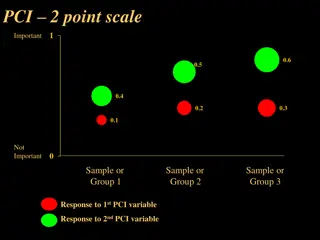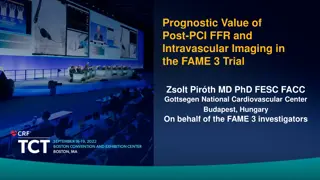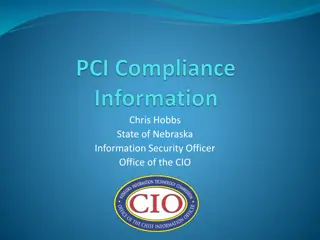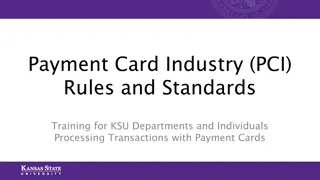Understanding PCI-DSS Compliance and Requirements
The Payment Card Industry Data Security Standard (PCI-DSS) is crucial for protecting cardholder data from fraud and breaches. This standard entails six objectives with specific requirements aimed at building a secure network, protecting data, maintaining vulnerability management, implementing access control measures, monitoring networks, and having a robust Information Security Policy. Compliance with PCI-DSS is essential for all merchants processing cardholder data, regardless of state or federal regulations. Adherence to PCI-DSS promotes consistent global security standards and safeguards sensitive payment information.
Download Presentation

Please find below an Image/Link to download the presentation.
The content on the website is provided AS IS for your information and personal use only. It may not be sold, licensed, or shared on other websites without obtaining consent from the author. Download presentation by click this link. If you encounter any issues during the download, it is possible that the publisher has removed the file from their server.
E N D
Presentation Transcript
Payment Compliance Review Office of Financial Operations & Business Technology Accounts Receivable Revised 02-2020
Agenda Security of Credit Card Data Credit Card Procedures Review
Security of Credit Card Information In January 2009 the University adopted section 13.14 of the WSU Policies and Procedures Manual. The purpose of the policy is to comply with the Payment Card Industry Data Security Standard (PCI DSS). PCI DSS is regulated by the payment card industry (Visa, MasterCard, etc.) PCI DSS is not endorsed or enforced by the State of Kansas. We must comply even though it is not a state or federal regulation. Compliance with PCI DSS is required of all merchants (i.e. WSU) that process, store or transmit cardholder data.
What is PCI-DSS? Purposes of PCI DSS? Promote consistent global security standards. Protect cardholder data from fraud and security breaches. The Six Objectives of PCI Build and maintain a secure network. Protect cardholder data. Maintain a vulnerability-management program. Implement strong access-control measures. Regularly monitor and test networks. Maintain a written Information Security Policy.
PCI DSS Goals and Requirements (1 of 2) PCI DSS has 6 goals with 12 requirements derived from a summary of over 200+ Standards for Compliance: Control Objective #1: Build and maintain a secure network Requirements: (1) Install and maintain a firewall configuration to protect data (2) Change vendor-supplied defaults for system passwords and other security parameters Control Objective #2: Protect cardholder data Requirements: (3) Protect stored data (4) Encrypt transmission of cardholder magnetic-stripe data and sensitive information across public networks Control Objective #3: Maintain a vulnerability management program Requirements: (5) Use and regularly update antivirus software (6) Develop and maintain secure systems and applications
PCI DSS Goals and Requirements (2 of 2) Control Objective #4: Implement strong access control measures Requirements: (7) Restrict access to data to a need-to-know basis (8) Assign a unique ID to each person with computer access (9) Restrict physical access to cardholder data Control Objective #5: Regularly monitor and test networks Requirements: (10) Track and monitor all access to network resources and cardholder data (11) Regularly test security systems and processes Control Objective #6: Maintain an information security policy Requirement: (12) Maintain a policy that addresses information security
PCI DSS applies to YOU! Everyone involved in any part of processing payment-card transactions must understand and follow PCI DSS. We ALL share an interest and a responsibility to protect cardholder data.
Costs of Non-Compliance or a Breach Non-Compliance costs include: Fines Lawsuits Investigation, notification and credit-watch expenses Loss of reputation and customer confidence Loss of ability to accept payment cards PCI DSS violations may lead to discipline, including termination.
Covered Data Elements (1 of 2) Standards were written to protect the following data: 1. Cardholder Data Includes: Primary Account Number (PAN) Cardholder Name Expiration date Service/Security code Storage of cardholder data is permitted as long as stored per standards. Only the first 6 or last 4 numbers of the PAN should be stored. Protection is required on all of these data elements.
Covered Data Elements (2 of 2) 2. Sensitive authentication data Includes: Magnetic Stripe CVC2/CVV2/CID PIN/PIN Block Storage of sensitive authentication data is NEVER permitted. These data elements are considered the Holy Grail for thieves.
Who Must Comply? Do you or your department collect, store, process or transmit cardholder data? Do you COLLECT cardholder data. . . On paper? Over the internet via a website (referred to as E-Commerce transactions)? Over the phone or through the mail? Enter directly into a PC, Point of Sale, a mobile device, etc.? Do you STORE cardholder data. . . On paper? In an electronic document (i.e. Spreadsheet, Word document, etc.)? Temporarily or permanently? Do you PROCESS cardholder data. . . Using any process (software application, hardware, etc.) to process cardholder data? Do you TRANSMIT cardholder data. . . To a third party in an effort to collect payment for goods or services? IF YOU ANSWERED YES TO ANY OF THE ABOVE QUESTIONS, THEN PCI DSS APPLIES TO YOU!
Common PCI DSS Myths I don t store credit card numbers, so I have no compliance obligation with the PCI DSS. I only process a few credit card transactions per year, so I am exempt from compliance with the PCI DSS. I only need to be mostly compliant with the PCI DSS.
Important Steps to Compliance PCI DSS requires WSU to identifyall payment points Payment Points are places where the cardholder data is being collected, stored, processed or transmitted. PCI DSS requires WSU to securethe payment points Secure the PC and the credit card terminal per PCI DSS. Grant access only to those who are trained in proper credit card procedures per PCI DSS. Connect the payment points to a private credit card network that is used specifically for credit card processing ONLY. Payment points are connected to a WSU private network whose sole purpose is to process credit cards.
Which are payment points that WSU must secure? (click to reveal answer) Card Swipe Machine? Office Workstations? YES YES if entering credit card data. Computer should not be used for ANYTHING else (i.e. email, daily job) Payment kiosk that department offers? YES any designated PC for the convenience of making payments. Student in dorm entering his own credit card on his own computer? NO Phone Transaction taken on a Laptop? Computer Lab? NO PCs are for generaluse not specific for payments. YES Laptop cannot be wireless.
Credit Card Procedures - Collection Collection of credit card information: Not Permitted: Electronic mail (email) NEVER process a transaction using cardholder data from an email! Permitted (if proper procedures are followed): Phone Mail In Person Fax (discouraged, but permitted) Fax machine should be accessible to departmental staff only. Faxes with cardholder data should print only when departmental staff are available to pick up fax pages (Fax option-code to print). Departments accepting cardholder data via fax cannot use the option that converts faxes to electronic documents (viewed through email).
Credit Card Procedures Access (1 of 2) Transportation of credit card information: Only employees who have been approved by the Office of Financial Operations & Business Technology and have regular access to credit card information should transport credit card information. Credit card information should always be treated as cash and transported in a locked bag. Limit access to credit card information to department employees on a need-to-know basis only. Unauthorized personnel should have NO access to cardholder data.
Credit Card Procedures Access (2 of 2) Any employee authorized to handle credit cards must be certified annually. All users must use their own ID/Password to access software used when processing cardholder data. Student workers processing bulk credit card transactions must have a background check. All users must complete FERPA training prior to accepting credit card payments.
Credit Card Procedures Storage Electronic storage of credit card information is NOT permitted. Temporary physical storage ANY document containing credit card information must be stored (maximum 2 days) in a locked cabinet/file. After credit card information has been processed: Destroy entire document or physically remove the credit card information from the paper form (cut out or off). Use a cross-cut or micro shredder to destroy credit card information. Permanent physical storage of credit card information within campus department is NOT permitted.
Credit Card Procedures Prevention of Tampering with Devices Verify the identity of any third-party persons claiming to be repair or maintenance personnel, prior to granting them access to modify or troubleshoot devices. Do not install, replace or return devices without verification. Be aware of suspicious behavior around devices (for example, attempts by unknown persons to unplug or open devices). Report suspicious behavior and indications of device tampering or substitution to appropriate personnel (for example, supervisor, security officer, or Financial Operations Accounts Receivable).
Credit Card Acceptance Procedures The credit card software and hardware (PC or terminal) being used must be approved by or assigned by Financial Operations & Business Technology (FOBT). TouchNet, Inc. is WSU s preferred software vendor for all WSU credit card processing needs. Credit card terminals must be issued and maintained by FOBT. Any device used to collect, process, store or transmit cardholder data must be issued and maintained by FOBT. Exceptions to the above may be granted by FOBT.
Credit Card Incident Response Plan (1 of 2) An incident is defined as a suspected or confirmed data compromise . A data compromise is a situation where there has been unauthorized access to a system or network where cardholder data is collected, stored, processed or transmitted.
Credit Card Incident Response Plan (2 of 2) In the event of a suspected or confirmed incident : Contact a member of the Incident Response Team AND send email to creditcards@wichita.edu with your contact information. If the incident involves a payment station DO NOT turn off the PC. Disconnect the network cable connecting the PC to the network jack (cut the cable if you do not have access to the jack key). Do NOT discuss the incident with anyone except your direct supervisor and the members of the Incident Response Team. Refer all inquiries regarding the incident to the Incident Response Team.
Credit Card Best Practices (1 of 3) In Person: Keep card reader in your line of sight. Store card reader securely when not in use. Report any suspicious behavior to member of Incident Response Team. Phone/Mail/Fax: Obtain security code on back of card for all sales (see slide #26) Write cardholder information only on designated forms. Store all documents containing cardholder data in a secure, locked area. When no longer needed for business or legal reasons, shred cardholder information using a cross-cut or micro shredder. Email: Never send cardholder data through email. If you receive cardholder data through email, do NOT process transaction. Delete email and empty your deleted items folder. Reply to customer with a NEW email. General: Process refunds to the card used for original purchase. Never share cardholder information outside of work environment.
Credit Card Best Practices (2 of 3) Never store credit card numbers in any database or spreadsheet. Mask all but last 4 digits of credit card number. Permit only those employees who have a legitimate need-to-know access to cardholder information. Do not allow unauthorized persons access to areas where credit card data is stored or processed. Document departmental procedures. Segregate duties the individual performing reconciliation should not be involved in processing credit card sales or refunds.
Credit Card Best Practices (3 of 3) Location of Security Code for Different Card Types
Related Information Policy & Procedure 13.01 / Deposit of Cash Receipts provides guidance concerning all deposits of University funds. Cash receipts include all of the following: U.S. Currency, U.S. Coins, Personal Checks, Credit Cards, Wire Transfers, Bank Drafts, Money Orders, Traveler s Checks, Cashier s Checks and Foreign Drafts (but not foreign currency) WSU Controls Assessment Tool https://www.wichita.edu/about/policy/cat3.php It is recommended that all employees authorized to accept funds on behalf of the University be trained on Cash Handling procedures every three years. (To access course, visit the Accounts Receivable section of the EmpHelp cube in the myWSU portal.)
Accounts Receivable 978-3070 or email wsuaccountsreceivable@wichita.edu Questions? The remaining slides will test your knowledge of the material covered in this presentation. Thank you for participating!
Review Question #1 What does the Payment Card Industry Data Security Standard help to alleviate? a) Debt b) Vulnerabilities and Breaches c) Theft of Cardholder Data d) Heartburn e) Both b & c Answer: (e) The PCI DSS protects both the cardholders and the University from fraudulent use of cardholder information through stringent practices and security measures.
Review Question #2 The PCI DSS consists of: a) Comprehensive Requirements b) Lots of Mumbo Jumbo c) Regulations for Generating Card Numbers d) Technical and Operational System Components e) Both a & d Answer: (e) The PCI DSS has 12 comprehensive requirements that are both technical and related to office processes.
Review Question #3 The full credit card numbers should never be stored after authorization: a) True b) False Answer: (a) True. To reduce the risk of fraudulent achievement of cardholder data, all card numbers should be truncated and stored securely.
Review Question #4 Physical access to cardholder data should be: a) In a Secure Area b) Locked Up c) Destroyed When No Longer Needed d) On a Need-to-Know Basis e) All of the Above Answer: (e) All of the Above. To reduce the risk of fraudulent achievement of cardholder data, all the above needs to be followed.
Review Question #5 What does PCI DSS stand for? a) Personal Card Industry Data Security Standard b) Payment Card Industry Data Security Standard c) Payment Card International Data Standards Site d) None of the Above Answer: (b) Payment Card Industry Data Security Standard
Review Question #6 When accepting a payment card over the phone, you should never ask for the cardholder s phone number. a) True b) False Answer: (b) False. Obtaining a cardholder s phone number can help you contact them.
Review Question #7 You are walking through campus and see that a student group is taking credit cards for a service they are offering. You aren t sure, but it doesn t look like they are following PCI DSS standards. What do you do? a) Ignore them. b) Ask them if the processing has been approved by Financial Operations. c) Give them your credit card information and purchase their service. d) Email creditcards@wichita.edu to see if the student group has been approved. Answer: (b) or (d), or both. For the protection of cardholder data and the University, it is ALWAYS good to report any questionable credit card processing on campus.
Review Question #8 You see that a document that contains the full primary account number of a customer. What should you do? a) Use a pen and mark it out. b) Put it in the trash. c) Continue the transaction because receipts should have the full account number. d) Email creditcards@wichita.edu AND call Financial Operations to inform the University of the problem. Answer: (d) The full primary account number should never be printed on any document or report. Any violation should be reported immediately.
Review Question #9 Which of the following best describes PCI DSS compliance? a) A one-time activity b) An ongoing process c) A game d) An achievement Answer: (b) PCI DSS is a never ending process. Original achievement of PCI DSS compliance is only the beginning. Continued proof of compliance must occur on an annual basis.


